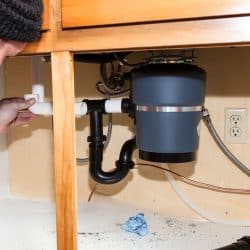What're your thoughts about Garbage Disposal Leaking From Bottom?

Waste disposal unit are important cooking area devices that aid in disposing of food waste efficiently. Nonetheless, a leaking garbage disposal can be a frustrating and untidy trouble to handle. Thankfully, many leakages can be taken care of easily with a couple of simple actions. In this write-up, we will certainly go over just how to repair a dripping garbage disposal successfully.
Introduction
Waste disposal unit are installed under cooking area sinks and are developed to shred food waste right into smaller pieces, permitting it to pass through the plumbing system easily. While these devices are usually dependable, leaks can take place with time due to deterioration, loose connections, or damages to the system.
Common Causes of Leaks in Waste Disposals
Worn Seals and Gaskets
Seals and gaskets play an important function in protecting against water from dripping out of the garbage disposal. With time, these elements can deteriorate, causing leaks around the disposal device.
Loose Connections
The connections between the garbage disposal and the pipes system can become loosened over time, triggering water to leak out during operation.
Fractures or Openings in the Disposal System
Physical damage to the garbage disposal, such as cracks or holes in the housing, can also cause leakages.
Identifying the Resource of the Leak
Prior to trying to take care of a dripping garbage disposal, it is necessary to recognize the resource of the leakage. This can usually be done via aesthetic evaluation or by performing basic tests.
Visual Examination
Examine the waste disposal unit unit meticulously for any signs of water leakage. Pay very close attention to areas around seals, gaskets, and connection points.
Testing for Leakages
One way to evaluate for leakages is by running water through the disposal system and checking for any kind of visible indications of leak.
Tools and Products Needed for Fixing a Leaking Waste Disposal Unit
Before beginning the fixing process, gather the needed tools and materials, including a screwdriver, flexible wrench, plumber's putty, replacement seals or gaskets, and epoxy or patching material for repairing fractures or holes.
Step-by-Step Guide to Taking Care Of a Dripping Waste Disposal Unit
Switch off the Power
Prior to trying any type of repair services, make sure that the power to the waste disposal unit system is turned off to prevent the threat of electrical shock.
Situate the Leak
Identify the specific location of the leakage and identify the cause.
Tighten up Connections
Use a wrench to tighten up any kind of loose links in between the disposal device and the pipes system.
Replace Seals or Gaskets
If the leakage is because of worn seals or gaskets, eliminate the old components and change them with brand-new ones.
Patching Fractures or Openings
For cracks or openings in the disposal device, usage epoxy or an appropriate patching product to seal the damaged location.
Testing the Garbage Disposal After Repair
Once the repair service is full, test the garbage disposal by running water with it to make sure that the leakage has actually been resolved.
Preventive Maintenance Tips to Avoid Future Leaks
To prevent future leaks, it is essential to carry out regular maintenance on your garbage disposal. This consists of maintaining it clean, preventing putting non-food things or tough items down the disposal, and regularly checking for leakages or other issues.
Conclusion
Finally, taking care of a leaking waste disposal unit is a fairly straightforward procedure that can be completed with standard tools and products. By following the actions outlined in this post and exercising preventive upkeep, you can keep your waste disposal unit in good working problem and prevent expensive fixings in the future.
What to Do About a Leaking Garbage Disposal
A leaking garbage disposal often goes unnoticed until you confront a sopping cabinet, a foul-smelling puddle, or an audible drip-drip-drip from the unit. The fix can be frustrating, too, because the leak can stem from a number of components in the system. Fortunately, with a little sleuthing, you can zero in on the leak and—depending on the exact location—stop the icky oozing and repair the component that caused it. Worst case scenario, if it turns out that the garbage disposal must be replaced, installing a new one is a reasonable do-it-yourself task for those with basic plumbing skills. Read on to keep the cash you’d otherwise hand over to a pro.
Prepare to find the leak
Prior to testing the garbage disposal for leaks, unplug it at the wall outlet and turn off the power from the breaker box to prevent electrical shock. Then insert a watertight sink stopper into your sink drain and wipe the unit dry with a clean cloth. In any handy container, mix a few drops of food coloring into a few cups of water, and pour the dyed water onto the sink stopper to help you locate the leak.
Investigate the source
the top, where the disposal meets the sink drain the side, where the dishwasher hose or main drain pipe connects to the disposal or the bottom of the unit Inspect each of these locations while gliding a light-colored rag over the unit; the dyed water will readily show on the rag and reveal the location of the leak. If a leak isn’t immediately apparent, remove the sink stopper and pour a few more cups of dyed water down the sink drain, then check for leaks again. Leaks near the top of the unit are more likely to show themselves while the sink is plugged, while side and bottom leaks are more noticeable while the sink is unplugged.
The metal sink flange that sits directly inside the sink drain is typically sealed around the top with plumber’s putty (a clay-like sealant) and then secured from under the sink with bolts. If the plumber’s putty deteriorates, or the bolts loosen, the flange can no longer form a watertight seal between the sink drain and the disposal—which could cause a leak at the top of the unit.
To reseal the leaky flange, you must first detach the garbage disposal. Start by loosening the screws securing the main drain pipe to the disposal, then loosen the screws in the metal clamp securing the dishwasher hose to the disposal and detach the drain pipe and dishwasher hose from the disposal. Loosen the screws in the mounting ring that connects the disposal to the metal mounting assembly beneath the sink, then pull down the disposal and carefully set it on a clean, dry surface. Loosen the bolts in the mounting assembly with a wrench, then pull down the mounting assembly and set it near the disposal.

I found that blog posting on The Handy Guide To Fixing Your Garbage Disposal Leaking when doing a lookup on the search engines. Those who appreciated our page plz do not forget to pass it around. Thank-you for going through it.
Schedule Now